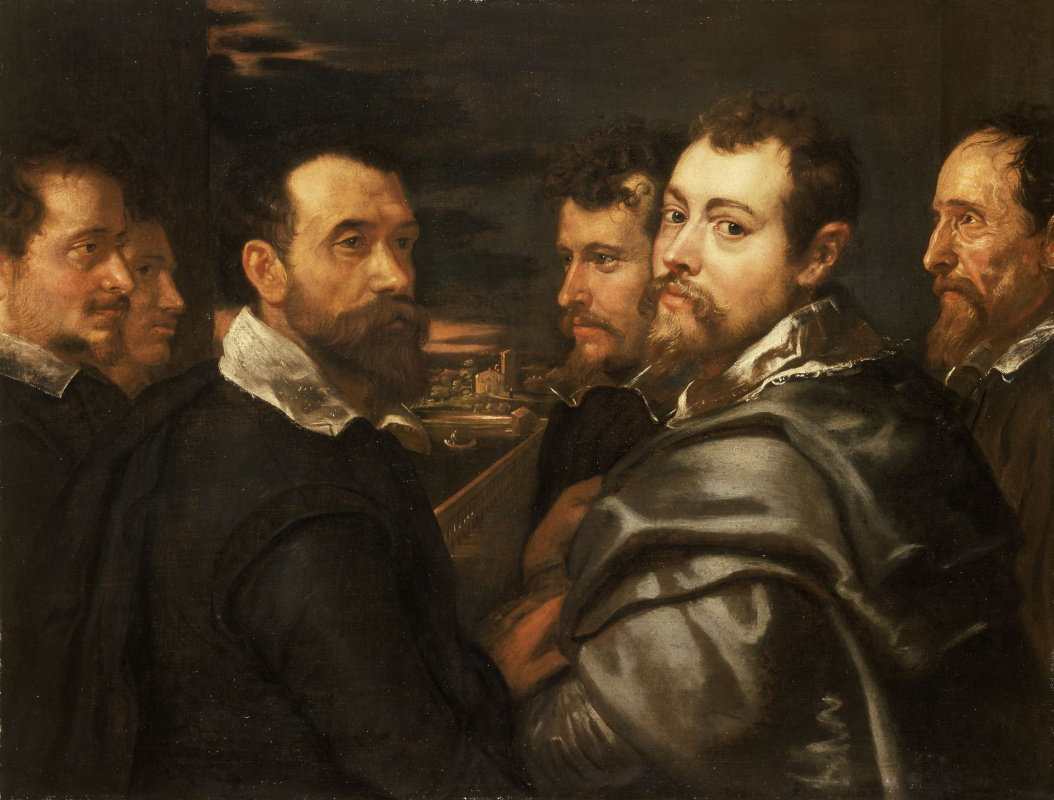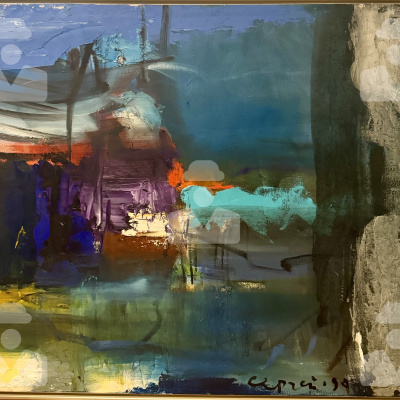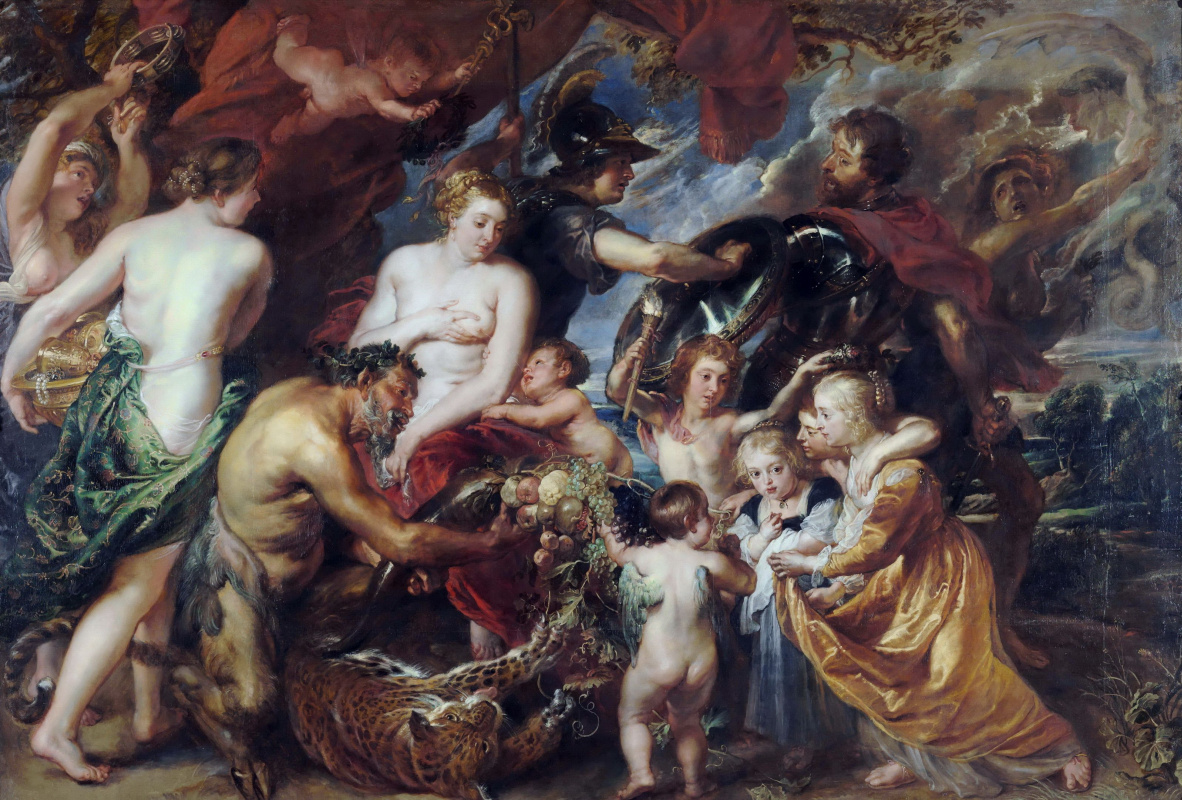Rubens began painting only by the age of 30, nevertheless he managed to create a well-established production of paintings right at home, was a friend of the Duke of Buckingham, several ministers and a pleasant conversationalist of European kings, left a diplomatic career after a great victory and received a noble sword from two monarchs.
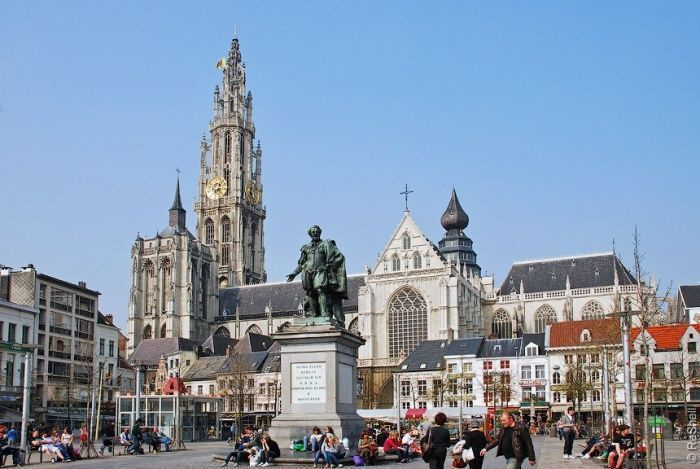
Self-portrait in a circle of friends from Mantua
1604, 78×101 cm
Rubens has been studying for more than 10 years. Peter Paul, the 14-year-old page of the Antwerp Countess de Lalaing, was not disposed to social life at all. A boy with an exceptional memory, he knew three living languages (Flemish, German and French), Latin and Greek, thus he was bored to death by being a page. He did not have any special inclinations or exceptional gifts hitherto. Calm and balanced Peter Paul let his parents deal with their adult problems and did not cause them trouble. But to be a page was really unbearable.
Understanding of his destination came to young Rubens in the most unreliable way, even more likely, by an untracked path. Because there were simply no big roads around Peter Paul: the Reformation removed all the picturesque images from the churches, his family was in exile and poverty, which meant that aristocratic castles with their collections were also closed for visiting. At home, there was only an illustrated Bible, which became the starting tool of his self-education: the boy diligently copied illustrations every day, trying to repeat every line exactly.
After he had been studying for 8 years and changed three Flemish teachers, Rubens went to Italy, where he continued to copy every interesting line that came across along the way: palace columns, paintings of his predecessors, travel impressions. He would create the first important independent work only by the age of 30.
Understanding of his destination came to young Rubens in the most unreliable way, even more likely, by an untracked path. Because there were simply no big roads around Peter Paul: the Reformation removed all the picturesque images from the churches, his family was in exile and poverty, which meant that aristocratic castles with their collections were also closed for visiting. At home, there was only an illustrated Bible, which became the starting tool of his self-education: the boy diligently copied illustrations every day, trying to repeat every line exactly.
After he had been studying for 8 years and changed three Flemish teachers, Rubens went to Italy, where he continued to copy every interesting line that came across along the way: palace columns, paintings of his predecessors, travel impressions. He would create the first important independent work only by the age of 30.
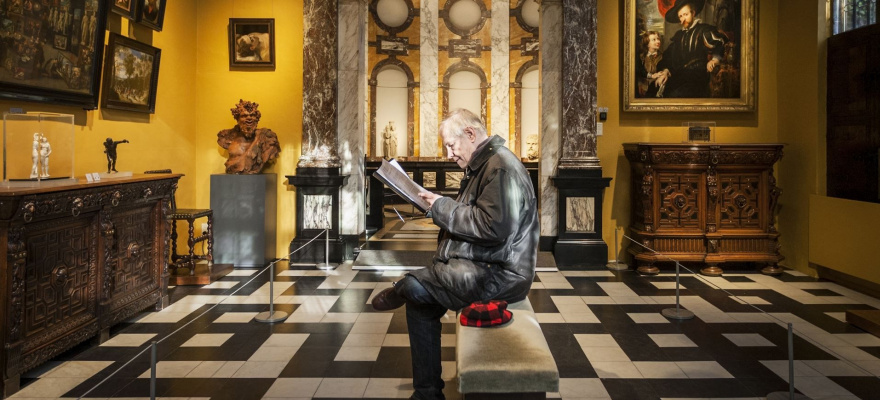
Rubens House in Antwerp is now considered one of the top 10 most interesting places to visit. (Photo by Ans Brys, from the Rubens Museum Facebook page).
Rubens was a brilliant businessman. In his house, there was a real manufactory for the production of paintings, a whole team of apprentices worked there all the time, and some of them were quite confident mature artists. But it was an honour to work with Rubens: he was a world-famous celebrity, and Rubens was a reliable provider of commissions and livelihoods.
Later, critics often scolded Rubens, an intelligent and even ingenious entrepreneur with a fine mental organization, because, they say, he turned art into a conveyor. In fact, he did not invent involving students into creating large-scale commissions. Michelangelo painted the ceiling of the Sistine Chapel, for example, together with his students. And before him, the walls of the same chapel had been painted by Botticelli, Ghirlandaio and Perugino, also with assistants.
The Flemish painter worked honestly. He did not hide the smooth-running mechanism of painting creation: he built a house-palace, in which most of the rooms were workshops, drew a sketch and gave it to his assistants who painted landscapes, draperies, animals, sky and backgrounds. Rubens always painted the subjects' faces himself and often worked through the canvases with a brush, adding details and important, lively touches. Modern European exhibitions sometimes show the original sketch and the finished picture nearby in the same room — the audience is struck by the accuracy and dynamic tension of Rubens’s plan. Just like a tart rare wine, diluted with water by the students.
Of course, he could draw a tree or a horse himself, but he compromised quite consciously, even to the detriment of his own reputation. Too many people wanted "their Rubens". And the artist could skillfully bargain: maybe you’d like, my dear sir, to have a canvas of a slightly smaller size, but already present and painted by myself, however, more expensive. Well, or wait a couple more months and you’ll get the picture cheaper, but it’ll be done by students and in the dimensions indicated by you (it would fit into the wall between the windows in your beautiful house), however, I’ll thoroughly check it with my brush, so you’ll not be able to distinguish it from mine.
Later, critics often scolded Rubens, an intelligent and even ingenious entrepreneur with a fine mental organization, because, they say, he turned art into a conveyor. In fact, he did not invent involving students into creating large-scale commissions. Michelangelo painted the ceiling of the Sistine Chapel, for example, together with his students. And before him, the walls of the same chapel had been painted by Botticelli, Ghirlandaio and Perugino, also with assistants.
The Flemish painter worked honestly. He did not hide the smooth-running mechanism of painting creation: he built a house-palace, in which most of the rooms were workshops, drew a sketch and gave it to his assistants who painted landscapes, draperies, animals, sky and backgrounds. Rubens always painted the subjects' faces himself and often worked through the canvases with a brush, adding details and important, lively touches. Modern European exhibitions sometimes show the original sketch and the finished picture nearby in the same room — the audience is struck by the accuracy and dynamic tension of Rubens’s plan. Just like a tart rare wine, diluted with water by the students.
Of course, he could draw a tree or a horse himself, but he compromised quite consciously, even to the detriment of his own reputation. Too many people wanted "their Rubens". And the artist could skillfully bargain: maybe you’d like, my dear sir, to have a canvas of a slightly smaller size, but already present and painted by myself, however, more expensive. Well, or wait a couple more months and you’ll get the picture cheaper, but it’ll be done by students and in the dimensions indicated by you (it would fit into the wall between the windows in your beautiful house), however, I’ll thoroughly check it with my brush, so you’ll not be able to distinguish it from mine.
Rubens was afraid of Van Dyck. He liked and appreciated him, of course, as well as recommended him to the European monarchs, and he instructed the young assistant to make copies of his paintings for engravings, and he sent him to Italy and France to assign copyright agreements, but he certainly saw Anthony as a dangerous rival.
Self-confident, educated and impulsive prodigy kid, sensitive to people and the world, Van Dyck came to Rubens' renowned workshop as an 18-year-old boy and began to live in his house. Very soon, customers of Rubens, forced to wait for their paintings for several months and pay a lot of money, began to whisper: "Van Dyck can do the same".
Rubens was smart enough and shrewd enough to estimate the threat posed by the student. Rubens biographers and van Dyck biographers tell the same story. Once the maître finished his huge canvas and went away from home. Inadvertently, the students smeared the fresh paint. Anthony confidently undertook to re-paint the spoiled fragment — and did just fine. Researchers on the part of van Dyck add "Rubens didn’t even notice anything", and on the part of his teacher — "on return, Rubens certainly noticed that the picture was redone, but did not say a word". In any case, the moment came when they could no longer live in one city: Rubens strongly recommended that the young man lived in Italy and studied the oeuvre of the Renaissance masters. Van Dyck was finally free.
Self-confident, educated and impulsive prodigy kid, sensitive to people and the world, Van Dyck came to Rubens' renowned workshop as an 18-year-old boy and began to live in his house. Very soon, customers of Rubens, forced to wait for their paintings for several months and pay a lot of money, began to whisper: "Van Dyck can do the same".
Rubens was smart enough and shrewd enough to estimate the threat posed by the student. Rubens biographers and van Dyck biographers tell the same story. Once the maître finished his huge canvas and went away from home. Inadvertently, the students smeared the fresh paint. Anthony confidently undertook to re-paint the spoiled fragment — and did just fine. Researchers on the part of van Dyck add "Rubens didn’t even notice anything", and on the part of his teacher — "on return, Rubens certainly noticed that the picture was redone, but did not say a word". In any case, the moment came when they could no longer live in one city: Rubens strongly recommended that the young man lived in Italy and studied the oeuvre of the Renaissance masters. Van Dyck was finally free.
Rubens was both an English and a Spanish nobleman. Back in 1608, having returned from Italy, having fallen in love and getting married right away, Peter Paul painted the wedding self-portrait with his wife Isabella. The newlyweds are sincerely happy, the artist himself shines, he is full of hope, calm and confident. And he has a sword. We see only the hilt, but Rubens leaves us no chance to leave it unnoticed, as he holds his hand on it.
At that time, he had no right to wear a sword yet, because he was not a nobleman. But he was self-confident, ambitious and completely devoid of philosophical youthful illusions about poverty as a source of inspiration. He was never embarrassed to ask the Archduke for his salary or the Duke of Gonzag to cover unforeseen expenses incurred on his way to Spain. He could leave for Rome on his business, while being in the service of the Duke of Mantua, and having been ordered to return immediately, he could write: "I will not be able to leave Rome so hastily because of some important work that I had to take upon myself (I admit this to Your Grace) out of necessity, for I devoted the whole summer to the study
of my art and was not able to maintain the house and two servants decently all the year for 140 scudoes received from Mantua for the entire time of my absence. In addition, I had the most wonderful and magnificent case that I could imagine in Rome, and the honour prompted me to take advantage of the mercy of my fate. We are talking about the main altar of the new temple of the Oratorian Fathers, called Santa Maria in Vallicella, now, without a doubt, being the most famous and most visited of all Roman churches. Although my aforementioned work has not yet begun, people of such a high rank are interested in it that I cannot refuse the order gloriously won from the best artists of Rome without deserving of censure." And the duke would allow Rubens to stay in Rome and finish the job! It is no surprise that the kings soon appreciated the Fleming’s diplomatic abilities.
Rubens would receive his long-awaited sword, and rightly so, from two kings, and the first one would be from the king of England. Charles I gave the artist a ring and chain with diamonds, and the University of Oxford awarded him a master’s degree in art. The king of Spain (Flanders then was part of Spain) would give him his sword a year later, without any rings or diamonds, but with recognition and in order to "give him the opportunity to show even more zeal in our service for sake of his honour".
Rubens would receive his long-awaited sword, and rightly so, from two kings, and the first one would be from the king of England. Charles I gave the artist a ring and chain with diamonds, and the University of Oxford awarded him a master’s degree in art. The king of Spain (Flanders then was part of Spain) would give him his sword a year later, without any rings or diamonds, but with recognition and in order to "give him the opportunity to show even more zeal in our service for sake of his honour".
Peter Paul Rubens. Peace and War. 1629−1630. Rubens presented this picture to the English king, having come to him with a peacekeeping mission.
Rubens stopped one war. And it was precisely for this that he received the nobility from the powers reconciled by him. The Thirty Years' War ended only 8 years after the death of Rubens, but the artist was able to influence its course.
Leaving for his first official diplomatic mission, Rubens compiled an inventory of his property and a testament for his two sons. Just in case. In the negotiations between England and Spain, he was significantly less noble than the other participants, but he appeared to be the most obligatory and punctual player in these four-year negotiations. King of Spain Philip IV did not believe that any painter could be involved in a matter of special national importance, but he did not take into account that Buckingham was a longtime friend of Rubens and recently bought a part of his antique collection from the artist, and that King of England Charles I considered Rubens to be one of the most interesting interlocutors and was ready to keep the Flemish artist around him as long as he could stand, conducting negotiations with Cardinal Richelieu behind him without any scruples.
The Thirty Years' War was a long, cruel and confusing event that significantly reduced the population of Europe and could become an indicative collection of intrigues, tricks, betrayals, unfulfilled promises and villains. In this whole story, Rubens looked like a knight: biographers agree that, besides vanity, he was certainly guided by a burning desire to bring peace first of all in his homeland, finally uniting Flanders and the United Provinces. For this purpose he put so much effort into establishing peace with England, which supported the United Provinces.
"More than anything else, I would like to return home and not go anywhere else," wrote 54-year-old Rubens just before the end of his exhausting Anglo-Spanish mission.
Cover photo: Monument to Peter Paul Rubens in Antwerp.
Author: Anna Sidelnikova
Leaving for his first official diplomatic mission, Rubens compiled an inventory of his property and a testament for his two sons. Just in case. In the negotiations between England and Spain, he was significantly less noble than the other participants, but he appeared to be the most obligatory and punctual player in these four-year negotiations. King of Spain Philip IV did not believe that any painter could be involved in a matter of special national importance, but he did not take into account that Buckingham was a longtime friend of Rubens and recently bought a part of his antique collection from the artist, and that King of England Charles I considered Rubens to be one of the most interesting interlocutors and was ready to keep the Flemish artist around him as long as he could stand, conducting negotiations with Cardinal Richelieu behind him without any scruples.
The Thirty Years' War was a long, cruel and confusing event that significantly reduced the population of Europe and could become an indicative collection of intrigues, tricks, betrayals, unfulfilled promises and villains. In this whole story, Rubens looked like a knight: biographers agree that, besides vanity, he was certainly guided by a burning desire to bring peace first of all in his homeland, finally uniting Flanders and the United Provinces. For this purpose he put so much effort into establishing peace with England, which supported the United Provinces.
"More than anything else, I would like to return home and not go anywhere else," wrote 54-year-old Rubens just before the end of his exhausting Anglo-Spanish mission.
Cover photo: Monument to Peter Paul Rubens in Antwerp.
Author: Anna Sidelnikova






